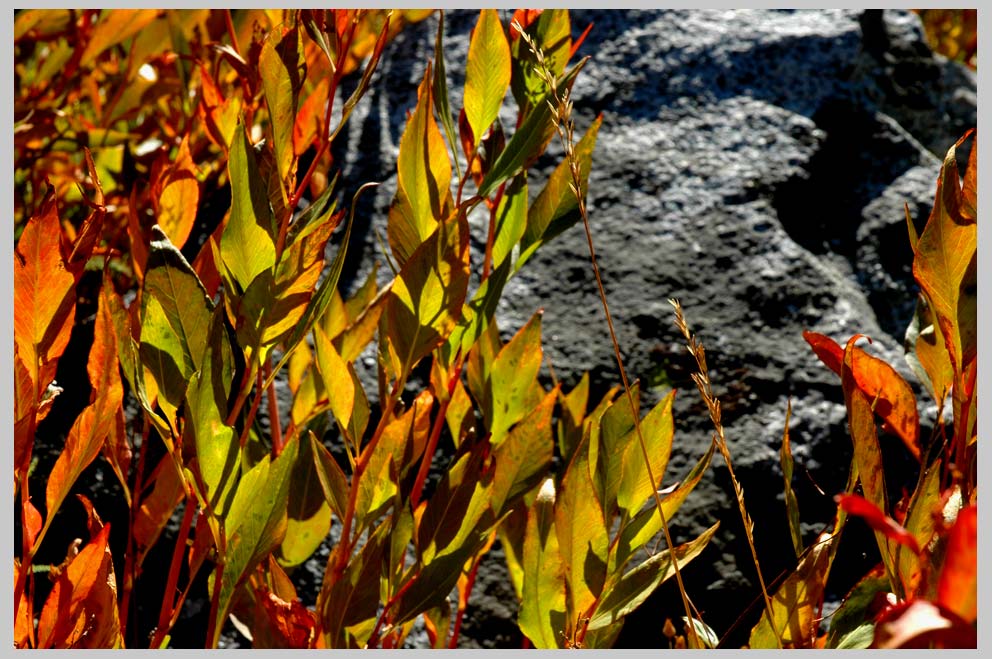

Alpine Fleeceflower on Granite (Polygonum phytolaccaefolium)
On the road in the American Northwest. [ click photo for next . . . ]


Alpine Fleeceflower on Granite (Polygonum phytolaccaefolium)
On the road in the American Northwest. [ click photo for next . . . ]
Member of the Buckwheat family——notice the knot-like swellings
giving the clan its other somewhat less charming common name,
Knotweed——after the first frost of highcountry autumn, the entire
plant loses its moisture, becomes paper-like in texture, and then
turns a stunning fiery orange to rusty red. With parboiling and
stirfying, much like, say, Burdock, the finger-thick roots
of Fleeceflower are not only edible but in my opinion a real
delicacy. If there is one plant to know in the Wallowas come
fall, this is it!
Eagle Cap Wilderness . . .
AN EXTINCTION OF A DIFFERENT KIND
Of all the extinctions currently underway—we are told we are at the dawn of
planet Earth’s sixth great extinction, with, for example, a quarter of all mam-
mals under threat, as well as a third of all frogs, to mention but a few—the one
that saddens and frightens me most receives little if any attention. It is the ex-
tinction of the free spirit. By “free spirit,” I mean exactly that: an intelligence
that is not tied to anything, and which can therefore find out the truth of a mat-
ter with integrity, independence, and, most especially, without fear of loss.
This is the man or woman, young or old—age here makes no difference—
who is capable of examining a thought or idea and following it like a thread
through a labyrinth of possible dead-ends, missed implications and inconsis-
tencies, to its logical ground and source.
My contention is that the man or woman of free spirit is becoming exceedingly
rare. I hope that I’m wrong.
THOUGHT EXPERIMENTS OF THE
COMPASSIONATE MIND
When strings at rest reflect in sympathetic resonance
other sounds near them, we hear the birth of Love &
Compassion in the physical world.
A key feature of the compassionate mind is evidently its need to move
freely with the unseen relational resonances implicit in every produced
or used artifact, every thought, every action. The apple may indeed
be superficially beautiful, but to ask how, where and by whom it was
grown, is a quintessentially spiritual question.
For the student of any age, the key thought experiment is: begin with
the end, or manufactured object, and then unravel it into its many
simpler constituent threads or parts, thereby going back in time and
space like a movie playing backwards. Imagine all the objects in a room
returning to their ultimate earth-bound source in this way. And then, run
the movie in your mind’s eye fast-forward until all the objects converge
again into their motionless, present form.
What parts of the movement are necessarily so? What parts are waste-
ful? What parts cause harm? Which objects do you now see as neces-
sary? Which do you see as wasteful?
It is the beginning of a much wider circle of ethical awareness.
Hummingbird Pass,
Eagle Cap Wilderness,
Oregon, X.29.2008
THE LITTLE CLAVIER please preview 150 of 631 pages
w/ my black & white photography [opens in new window]
Let me know how you like it!
Featured gallery, mountain water . . . .Please visit my MOUNTAIN WATER Gallery—some of
the best of my flowform photography w/ a selection of the highest quality
prints & frames . . . [ mouse over for controls / lower right fro full-screen ]
All Photographs & texts by Cliff Crego © 1998-2016 picture-poems.com
(created: X.11.2008)